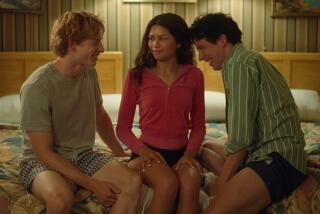Jaeger focuses on serving God, helping kids
- Share via
HESPERUS, COLO. — The waist-length pigtails are gone, replaced by a layer of dusty blond hair so short it doesn’t need a brush. Those ‘80s tennis skirts are history too. In their place, a black nun’s habit belted with a band of white rope that her dogs like to chew.
One constant: Sister Andrea Jaeger isn’t quite who everyone might think she is.
Even when she was a teenage tennis star -- all backhands and braces -- she knew she wouldn’t last long in that world, though hers was not a typical tale of burnout or overbearing parents. She succumbed to an injury early. When it took her off the court for good, she felt a sense of relief, because it allowed her to pursue her real passion -- helping children.
Through all that, she built a profound relationship with God, one that gave her direction at first, then the strength and motivation to navigate the good and bad times that came later.
A few months ago, at age 41, Jaeger became a Dominican nun -- the next, but not final, step on a journey hardly anyone could have envisioned in the ‘80s while she was perfunctorily dispatching women twice her age on the tennis court en route to No. 2 in the world.
“I didn’t do anything according to a formula people were used to seeing,” said Jaeger, still trim and fit even though she rarely plays tennis anymore.
She told about one of her first visits to see sick kids, after she sneaked away from Madison Square Garden to visit the Helen Hayes Hospital, north of Manhattan.
In one room, a girl was rigged up to a huge IV pole and she carried it around pretending it was her dance partner. Another was bald, and Jaeger figured that girl would be jealous when she reached out and felt Jaeger’s long pigtails.
“But she gave me a look, like, ‘You’ve gotta wash and dry that?” Sister Andrea said. “At that very moment, I felt like God was saying to me, ‘When you grow up, you’re going to help kids stuck in the hospital.’ At 15, I thought, ‘This tennis thing is great, but it’s not what I want to do when I grow up.’ ”
Jaeger described her evolution into the sisterhood as a process and a calling, not a sudden decision. Becoming a nun meant a change in uniform (she is currently without her veil, because the dogs got hold of it and chewed it up), but didn’t alter much in her outlook. She has always had a good relationship with God. She has always worked hard to help others.
Nuns these days have come a long way from when they threw erasers and rapped the knuckles of misbehaving Catholic school children.
Jaeger is a Dominican Anglican nun. She doesn’t have to live in a convent and can live what, to others, might be seen as a “normal” life. She did, though, take vows and must live a life devoted to service.
She’s not alone. Though statistics show a decline in the number of nuns -- from nearly 180,000 in 1965 to 66,000 last year, according to the Center for Applied Research in the Apostolate -- there is anecdotal evidence of a recent surge of women joining the sisterhood.
For instance, the Dominican Sisters of Mary in Michigan started with four sisters 10 years ago; there are now 71.
“I think women who are getting older might want to dedicate their lives and commit to something,” Jaeger said. “So, hey, if you always want to know you made the right choice, dedicating your life to God is always going to work. Because he’ll lead you to wherever it is.”
The place for Sister Andrea is a ranch outside Durango, Colo., the new home of her life’s work -- the Little Star Foundation. After she blew out her shoulder in the 1985 French Open at age 19, Jaeger poured the $1.4 million she’d earned, bit by bit, into an effort to help young cancer patients and other disadvantaged children.
Part of the liquidation included selling her Mercedes. As a tribute to her father, Roland -- who taught her the game thinking it would allow her to live a life of leisure as an adult -- she saved the German license plate from the car and brought it home as a present.
“He was horrified that I’d sold the car,” Jaeger said. “I knew he liked the license plate. I thought I was being sensitive. It took him like 10 years to get over that.”
It wasn’t until years later, when he saw his daughter handing out awards at a ceremony for her kids, that Roland Jaeger came around.
“He said, ‘This is my proudest moment. No tennis trophy can compare to this,’ ” Sister Andrea recalled.
And finally, a father who had seemed more like a coach to this young phenom, understood.
He’s not the only one.
“I am so amazed at how you knew your purpose at such a young age,” Diane Peacock, whose son has cancer and has been touched by Jaeger’s kindness, wrote to Jaeger recently. “Your spirit and enthusiasm is very clear, and we thoroughly enjoyed your visit.”
Sister Andrea’s enthusiasm has led many celebrities, in and out of the tennis world, to donate time to her cause.
Andre Agassi, who does his own charity work for children, has chipped in. So has Cindy Crawford. Yes, the supermodel. Crawford had a brother die young of leukemia and knows what it’s like to be part of a losing battle against cancer.
“You’ve got Cindy Crawford there telling kids that it’s the beauty on the inside that counts,” Jaeger said. “That’s quite a message coming from her. People listen to that.”
Little Star is set on a sprawling ranch in southwestern Colorado near the La Plata River. The headquarters is an immaculate, Southwestern home with high ceilings, brown tile, marble kitchen countertops and a fireplace. In one corner of the house is Jaeger’s office -- her “to-do” room -- that is filled with potential donors to call, hospital visits to schedule, itineraries to complete, children to help.
Jaeger recently moved her foundation down to Hesperus from Aspen, and construction is continuing on the new facility, which will include dorm-style living quarters, a horse barn and plenty of room outside to play.
Soon, children with cancer and their parents will come down for retreats, horseback riding, rafting, skiing. They’ll be able to attend prayer sessions, but those won’t be mandatory. In the meantime, Sister Andrea does as she always has -- taking her show on the road to Los Angeles, New York, Fort Lauderdale, Fla., and elsewhere for hospital visits. She takes the kids out of those hospitals and on field trips, helping them in their attempt to live life to the fullest.
“The whole point is that, yes, you are getting news that’s horrible, that could be haunting,” Jaeger said. “We’re not changing that news. We’re just changing how you can deal with it, and really, isn’t that what life is all about anyway -- how you deal with it?”
Jaeger’s biggest challenge over the last several years has been raising the money to keep the foundation running. Like many charitable organizations of this ilk, fundraising has become increasingly difficult as the money has gone elsewhere since the Sept. 11 attacks and Hurricane Katrina.
Jaeger’s goal is to have an annual operating budget of $4.3 million to fund Little Star’s programs. That’s a lot of money, but these aren’t just one-stop, one-visit events, the impact of which are often lost soon after the holiday or the moment is gone.
What Jaeger has learned in two decades of studying pediatric oncology is that while health care is improving and children are living longer, the quality of life in a hospital room isn’t getting much better. Thus, her goal is to make Little Star part of a life experience, not just a single hospital visit.
Jaeger saw her path developing at a young age, and it started crystallizing when she became a pro at 14.
Besides room service, which she found fascinating and freakish -- “They said 30 minutes and I timed them, and they did it,” she recalled incredulously telling her mom once -- the highlights of her tennis trips were her side journeys to hospitals to take toys to sick children.
Those in tennis circles of that era didn’t agree.
This was the mid-80s, when the fruits of Billie Jean King’s push for equality and of Chris Evert and Martina Navratilova’s popularity were really starting to kick in. The focus on the tennis circuit was tennis, not charity.
Jaeger remembered being called into the office by the tour’s top brass, expecting a lecture on bad manners and arguing line calls. Instead, they threw a copy of the New York Times at her with a story about Jaeger visiting a high school to talk to students about two suicides that occurred at the school in the span of a few days.
“I just got yelled at, told to quit doing it, because I was making the rest of them look bad,” Jaeger said.
That didn’t mesh with her way of thinking. Nor did the vibe in the locker room, where losses were met with devastation and wins were hard to celebrate, at least for her, because she knew the pain they inflicted on others.
“I don’t think anyone understood the mind-set of someone who wasn’t committed to being No. 1 in the world,” said Jaeger, who reached No. 2, but conceded she tanked matches precisely to avoid the top spot. “To me, it was, when I’m on the tennis court, I’ll swing a racket back and forth and chase a few balls. When I’m not on the court, I’m going to do what I feel God has called me to do, and I’m going to be a kid. If that’s the worst thing they can say about me, then hats off to them.
“They didn’t get it then. Now, they do.”


